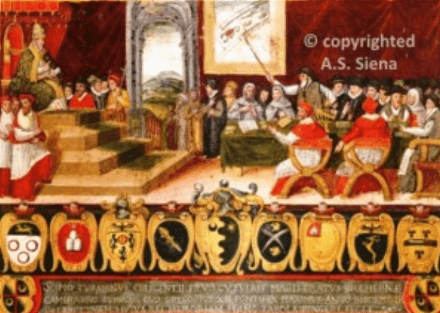If it wasn’t for this brilliant Calabrian you and I wouldn’t even know what day it was, but unfortunately, his great contribution bears someone’s name. As Michele Connors explains, Luigi Lilio, one of the greatest minds in Calabrian history, changed the way we see the world.
Welcome, Michele.
How much Calabrian history has been lost to the hands of time and how much is left to be discovered? This was the question that popped into my head after attending a lovely lecture by Dr. Francesco Vizza held on the terrace of the local museum in Ciro’ Superiore, Calabria this August. He talked about Luigi Lilio, possibly the most famous citizen ever to live in Calabria (except maybe Pythagoras), who was forgotten somehow over time. Who knows how this was possible since he made such a major contribution to society! This illustrious astronomer and mathematician created what is known as the Gregorian Calendar in the 1500’s, though it should be known as the Lilian Calendar. We are still using this calendar today.
In the mid 1500’s, Pope Gregory the XIII had a problem – the calendar wasn’t behaving as he wanted it to. Everyone was using the Julian calendar at the time. That was fine except that, due to some miscalculations for how long it took the Earth to revolve around the sun, the calendar dates were changing every year. Among other problems, this meant it was hard to follow the Bible’s rules about when Easter should be. The Bible states that Easter would be on the Sunday following the full moon following the Vernal Equinox (learn more here). Considering that the Julian Calendar wasn’t calculating the moon’s movements correctly, this wasn’t working out.
The Pope sent out word that all of the best astronomers and mathematicians had to solve this problem, not necessarily for the sake of a correct calendar that respects the moon’s movement, but more for this annoying little Easter date issue. He created a committee to solve it. Luigi Lilio’s grand discovery was that there were a few numbers missing in the number of days it took for the Earth to revolve around the sun, and solved the problem. He advocated for three common years followed by one leap year to make up for the difference, plus a complicated discovery about the epacts (age of the moon) that helped solve the Easter date mix-up.
Here is Luigi presenting his work to the committee. Note the man on his right who is counting on his fingers!
One of the most fascinating component’s of Lilio’s work was what he didn’t have at his disposal at the time. No telescopes, as those were brought from Northern Europe later on in the 1500’s and famously used by Galileo. He was also theoretically calculating these extremely complicated movements of the moon before the decimal point was discovered! Many say the decimal point was “discovered” by Scottish mathematician John Napier in the late 1500’s, but there is some doubt that maybe Luigi Lilio was already using it when he was making his calculations for the new calendar. If he did already know about it, the proof would be in his manuscripts, but only some have been recovered. Some think the rest of his manuscripts are located in the Vatican library which is not open to all scholars.
Let’s hope that someday one of the historians trying to remind Calabrians about their famous ancestor gets to enter the library and find out what else Luigi Lilio discovered.
This post was written by Michele Connors, my Calabria-spouse counterpart who blogs at Mignon Potenza. Visit her site there for more great stories about expat life, Italian food, wine and more.
Would you like to find out more about your relatives in Calabria? Click here to see how we can help.











Thanks so much for featuring this post and allowing me to “guest” over here, Cherrye!
Here’s an idea of how hard it might be for these scholars to get into the Papal “Secret” Archives: http://www.slate.com/articles/life/welltraveled/features/2011/vatican_inside_the_secret_city/vatican_guide_the_wonders_inside_the_legendary_secret_archives.html